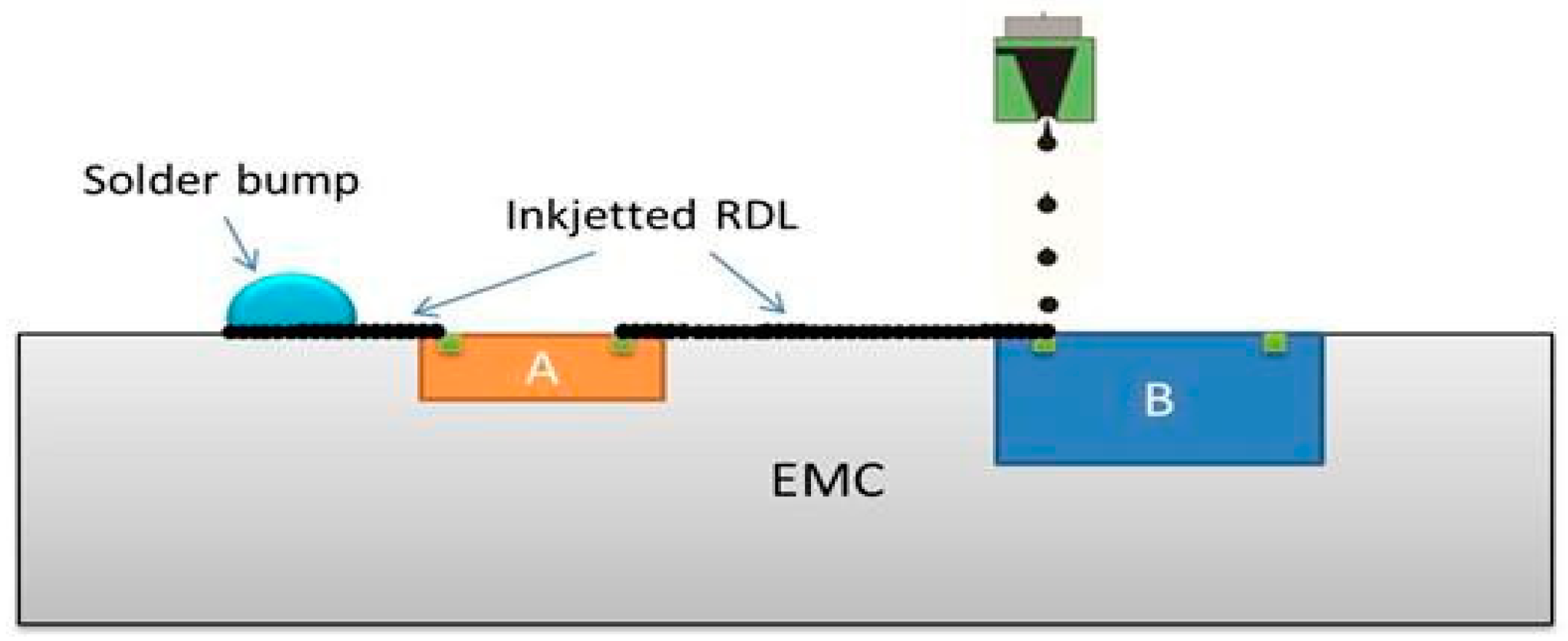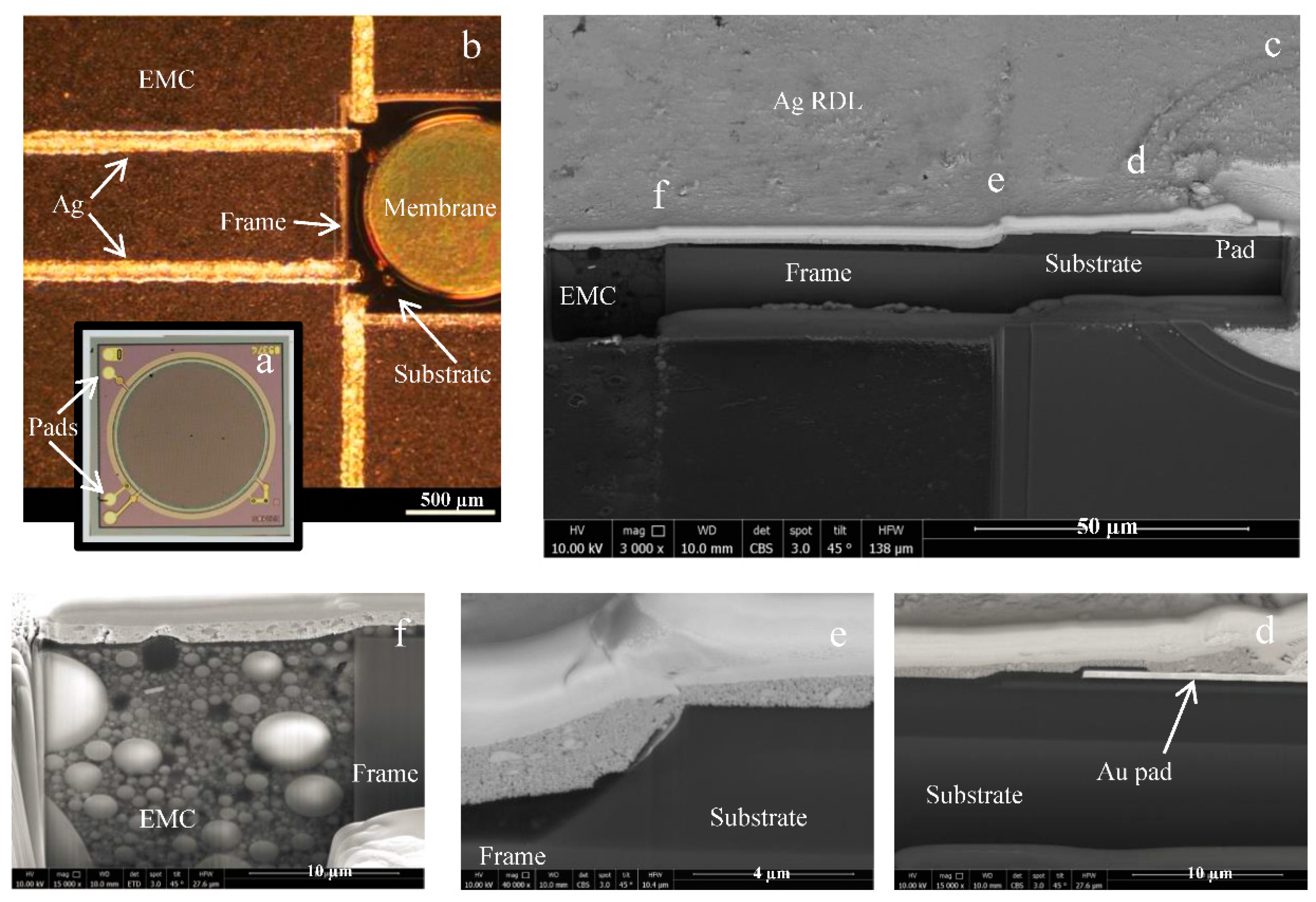The Realization of Redistribution Layers for FOWLP by Inkjet Printing
Abstract
:1. Introduction
2. Materials and Methods
2.1. Methodology
2.2. Materials
3. Results and Discussion
4. Conclusions
Acknowledgments
Conflicts of Interest
References
- Braun, T.; Becker, K.F. Trends in Fan-out wafer and panel level packaging. In Proceedings of the 2017 International Conference on Electronics Packaging (ICEP), Yamagata, Japan, 19–22 April 2017; pp. 325–327. [Google Scholar] [CrossRef]
- Lujan, A.P. A cost analysis of RDL-first and mold-first fan-out wafer level packaging. In Proceedings of the 2016 International Conference on Electronics Packaging (ICEP), Sapporo, Japan, 20–22 April 2016; pp. 237–242. [Google Scholar] [CrossRef]
- Braun, T.; Kahle, R. Fan-Out Wafer and Panel Level Technology for Advanced LED Packaging. IWLPC Conference Proceedings. 2017. Available online: www.smta.org/knowledge/proceedings_abstract.cfm?PROC_ID=5118 (accessed on 24 October 2018).
- Chia-Yen, L.; Tsai, H. Printing Method for Redistribution Layer and Filling of through Silicon Vias Using Sintering Silver Paste. In Proceedings of the 2014 9th International Microsystems, Packaging, Assembly and Circuits Technology Conference (IMPACT), Taipei, Taiwan,, 22–24 October 2014. [Google Scholar] [CrossRef]
- Chen, S.P.; Chiu, H.L.; Wang, P.H. Inkjet printed conductive tracks for printed electronics. ECS J. Solid State Sci. Technol. 2015, 4, P3026–P3033. [Google Scholar] [CrossRef]
- Krivec, M.; Roshanghias, A.; Binder, A. 3DInkPack—Inkjet Printing of Discrete Sensor Packages for Advanced Rapid Prototyping. Proceedings 2017, 1, 609. [Google Scholar] [CrossRef]
- Roshanghias, A.; Krivec, M.; Bardong, J. Printed SAW transponder package for rapid prototyping of electronic packages. In Proceedings of the 2016 6th Electronic System-Integration Technology Conference (ESTC), Grenoble, France, 13–15 September 2016. [Google Scholar] [CrossRef]
- Roshanghias, A.; Krivec, M.; Baumgart, M. Sintering strategies for inkjet printed metallic traces in 3D printed electronics. Flex. Print. Electron. 2017, 2, 045002. [Google Scholar] [CrossRef]



| Method | Thickness (µm) | Width * (µm) | Electrical Resistivity (Ω.m) | Relative Conductivity σ/σ(bulk) |
|---|---|---|---|---|
| Inkjet Ag (this study) | >1 ** | 80 | 5.61 E-8 | ~33 % |
| Litho + Cu plating | 5-10 | 25 | 1.72 E-8 | ~100 % |
| Litho + Ag plating | 5-10 | 25 | 1.59 E-8 | ~100 % |
Publisher’s Note: MDPI stays neutral with regard to jurisdictional claims in published maps and institutional affiliations. |
© 2018 by the authors. Licensee MDPI, Basel, Switzerland. This article is an open access article distributed under the terms and conditions of the Creative Commons Attribution (CC BY) license (https://creativecommons.org/licenses/by/4.0/).
Share and Cite
Roshanghias, A.; Ma, Y.; Dreissigacker, M.; Braun, T.; Bretthauer, C.; Becker, K.-F.; Schneider-Ramelow, M. The Realization of Redistribution Layers for FOWLP by Inkjet Printing . Proceedings 2018, 2, 703. https://doi.org/10.3390/proceedings2130703
Roshanghias A, Ma Y, Dreissigacker M, Braun T, Bretthauer C, Becker K-F, Schneider-Ramelow M. The Realization of Redistribution Layers for FOWLP by Inkjet Printing . Proceedings. 2018; 2(13):703. https://doi.org/10.3390/proceedings2130703
Chicago/Turabian StyleRoshanghias, Ali, Ying Ma, Marc Dreissigacker, Tanja Braun, Christian Bretthauer, Karl-F. Becker, and Martin Schneider-Ramelow. 2018. "The Realization of Redistribution Layers for FOWLP by Inkjet Printing " Proceedings 2, no. 13: 703. https://doi.org/10.3390/proceedings2130703
APA StyleRoshanghias, A., Ma, Y., Dreissigacker, M., Braun, T., Bretthauer, C., Becker, K.-F., & Schneider-Ramelow, M. (2018). The Realization of Redistribution Layers for FOWLP by Inkjet Printing . Proceedings, 2(13), 703. https://doi.org/10.3390/proceedings2130703






